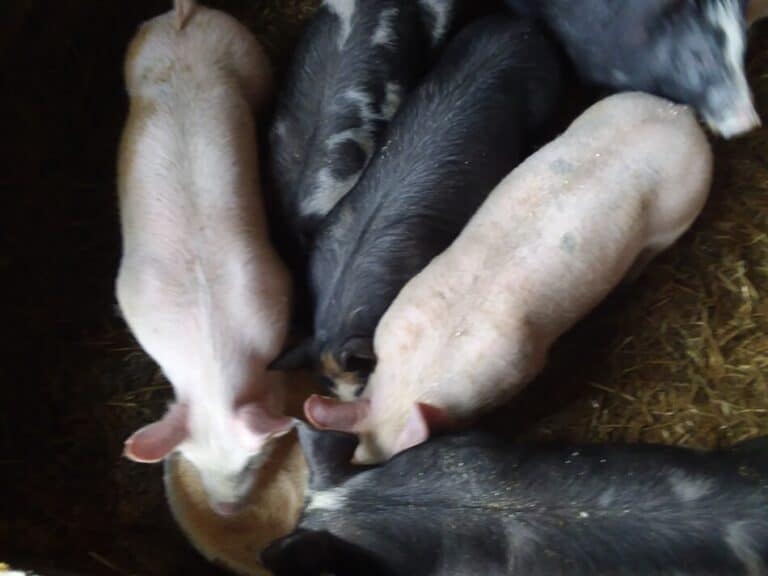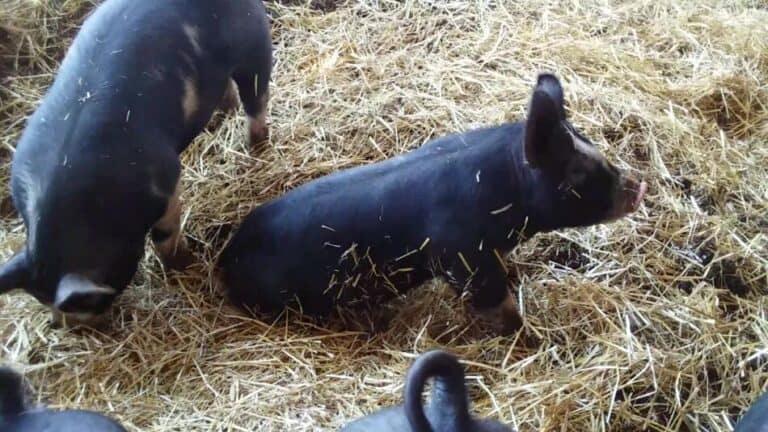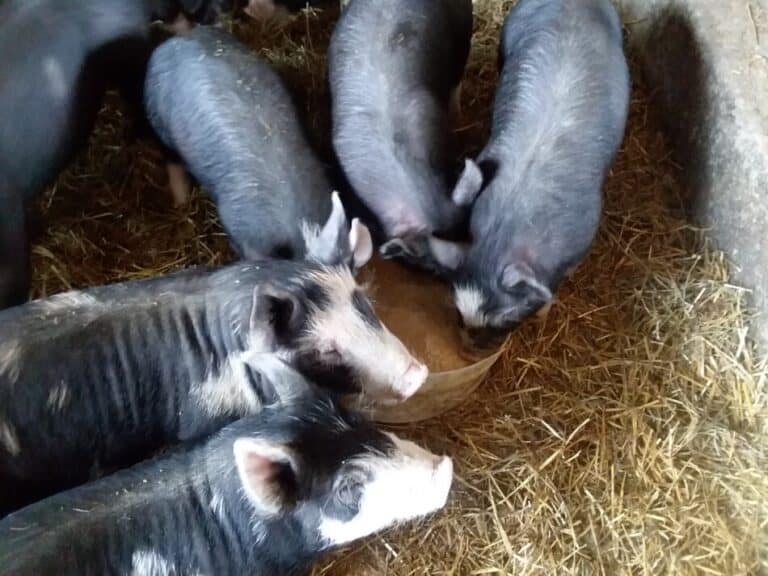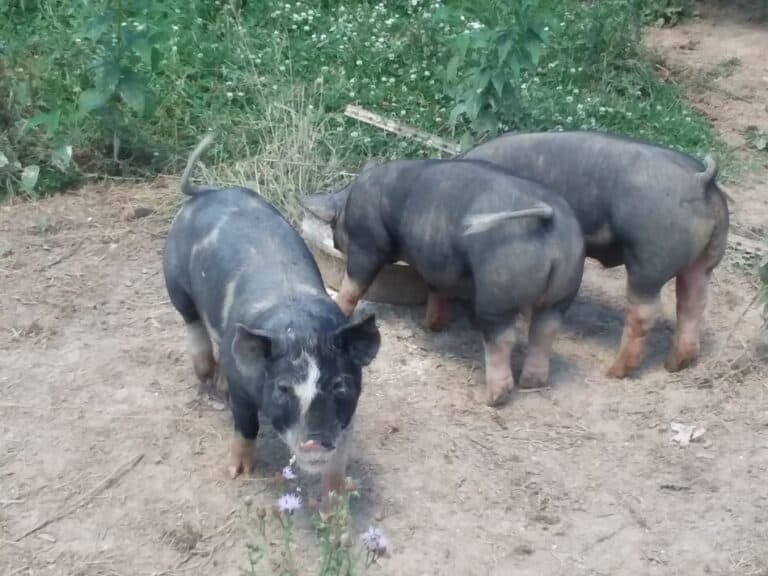How Much Can You Sell A Pig For?
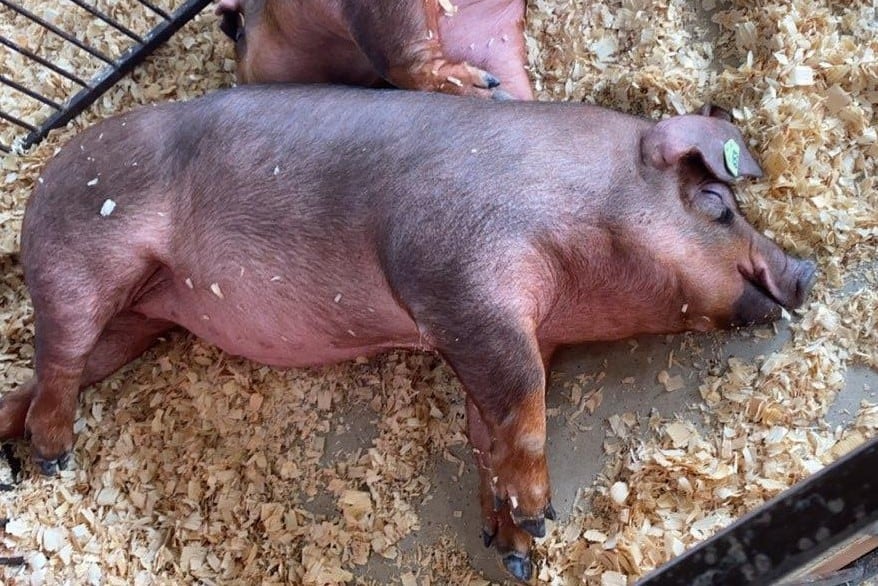
Pig prices, that’s a big topic! Depending on who you are talking to, pig prices could be for selling feeder pigs, ready to butcher pigs, breeding stock or wholes, halves or cuts!
We need some clarity, what pig is selling for which price?
I’ve put together a list of the current prices for all of these categories, in an easy to read chart with explanations and links to the reference sites listed out below.
Feeder pigs sell for $50-400 each, depending upon demand, breed and time of year. Whole or half hogs sell for $5.00 per pound hanging weight. Breeding stock pigs sell for $400-3,200+ each depending upon genetics and demand.
Buckle in, we’re going to cover a lot of area, here! Please remember, all prices are variable based on location and what is important to the buyer.
Check out the specific links to get an idea of which prices apply to you and your pigs.
| Type of pig for sale | What you are selling | Price |
| Feeder pigs (off season) | 50 pound weaned piglets born at your farm that the buyer will feed to finishing weight | $35-50 each |
| Feeder pigs (spring and summer) | same as above | $90-150 each |
| Feeder pigs (unusual/special genetics) | same as above | $150-400 each |
| Market hog (commercially) | 280-300 pound butcher ready pig, final size will depend upon local preferences | $280-300 each |
| Whole or half hogs (sold by hanging weight) | finished pig delivered to the butcher shop (processing fees included, customer picks up the packaged pork) | $5 per pound (hanging weight) |
| Whole or half hogs (sold by live weight) | same as above | $3.25 per pound (live weight) |
| Retail cuts of pork | packaged and frozen retail cuts of pork (includes costs to raise, butcher & profit from the pigs) | $ 9.53 per pound (range of $7.76-15.57) |
| Breeding stock pigs | pigs of breeding quality *most pigs born will not meet this higher standard and should be culled/sold for meat* | $400-3,200 each |
Pigs sell for supply and demand based prices at auction
Pigs are selling for $1.00 per pound, at auction, for both feeder pigs and market hogs. This price changes with demand.
The easiest answer to how much do pigs sell for is to base your price off of the local (or as close to local as you can get) auction prices.
This information is easy to find, just look up a few auction reports for your area or region.
Around here there is a steady demand for feeder pigs as well as finished hogs.
Many people, especially in the Amish communities, like to have a fat hog for their winter meat supply and to use as a fat source to mix with venison.
Right now, fat hogs (pigs ready to be butchered) are bringing around $1.00 per pound live weight, which would be $280-300 per head.
Feeder pigs are bringing $40-60 each for normal, every day nice looking feeder pigs. This is normal, usually by now (fall) the feeder pig price has dropped from the higher spring prices of $90-120 each.
Find these prices in your an auction market report. Here is the market report from one of our local auctions, Mt. Hope Auction.
Pick the specific date you want to see, note the auctions go back a few years, so you can see price trends.
Raise Feeder Pigs Or Buy Them? is my article that will help you figure out if you are better off moneywise to keep a sow or two or to buy the feeder pigs you need as you need them.
Pigs can be privately sold as feeders, whole or half, or retail pork
One of the great things about pigs is that you have so many options as to how to sell them!
Pigs can be sold as feeders, roasters, or as whole or halves and as retail cuts, depending upon what your area needs and wants.
Feeder pigs will be the least cost
Feeder pigs, weaned pigs that are 50-60 pounds, will be the lowest cost pig, both to buy and to sell. This is because they are the youngest and have the furthest to go until they hit market or breeding age.
Feeder pigs can be sold year round, but normally there is a certain time of the year that is high demand. Around here it is the spring. Check out the market reports for your area, you’ll figure it out pretty quickly!
Market hogs are finished pigs ready to be butchered
The next step up for pig raising is selling market hogs, which are butcher ready pigs. You would do all the work to get the pigs to full size, then sell them on the open market to an auction or a local butcher.
In our area, market hogs are sold at 280-300 pounds for the best prices, however, some areas sell hogs at much lighter weights, like 160 pounds. Either way, the purpose of these pigs is for them to go to processing immediately.
Before you start up this type of operation, be sure you have a plan for all of your pigs.
There is no point in raising pigs if no one in your area is buying or there are no slaughter houses within a comfortable driving distance.
If you have your own feed, this is a great option.
If you are buying feed, you should be sure to do your budget first and see that raising pigs on purchased feed and selling them commercially makes money sense.
Spoiler alert: selling for local auction price probably is a losing proposition! Buying feed will be a profit killer for you! Double check your numbers before you get started.
Whole or half hogs will be more money
Whole or half hogs sell for $5.00 per pound based off of hanging weight.
For the $5.00 per pound, everything involved in raising and processing the pig is included. The customer only pays the farmer and picks up the freezer ready meat.
$5.00 per pound hanging weight is a good amount, about $1,000 for a 280-300 pound pig. Remember, from $1.50-3.00 per pound of the meat goes to the processor, paid by the farmer.
Check out the sales page of Crooked Creek Hollow Farm in New Hampshire, they have a simple explanation of how they figure up prices.
Here’s a farm in my state, Ohio, that prices pork by the pound live weight. Six Buckets Farm charges $3.25 a pound for the live pig, which includes all processing fees and a delivery to one of their delivery sites.
This would work out to be $845-910 per pig, depending upon the size of the pig before processing (260 or 280 pounds are the examples I used).
Area demand will determine how willing folks are to buy your pork
These are huge opportunities!
As long as you realize (and figure into your budget) this is all about area and demand. If a ton of pigs are available for customers in your area, your area appropriate price will be lower than this.
Selling price of your pork depends upon your customer’s needs, your selling proposition and how much that matters to the customers.
Are you selling organically fed pigs, pastured pigs or small farm raised “like your grandparents did” pigs?
Each of these methods of raising pigs will take different amounts of work from you, require different inputs and should have different prices.
You’ll have to do research to figure up what is needed in your area.
Whole or half hogs will bring you more total money per pig because they also take more work on your part than just sending the pigs to an auction when they are at market weight.
Not only are you raising the pigs to finishing weight, you are also figuring out your customers and coordinating with them.
You’ll have the same amount of work into the pigs as a person selling to the auction, but you’ll get paid more because you are also working with the customer directly.
Usually whole hogs are a bit less money per pound than half hogs. This price can be based on live weight, hanging weight or pounds of packaged meat.
Normally, folks selling whole and half hogs go with hanging weight.
Another options for pig sales is roaster pigs. These are pigs sold for party style, whole hog on a rotisserie (or something similar) social events.
The live weight range for roasters can be just about anything in between feeder and market hog size. This is an awesome opportunity, if folks in your area love a to have a “pig in the ground”.
Retail cuts of pork bring the most money per pound
The highest money per pound is selling retail cuts directly to the customer. The prices for retail cuts go from $7.76 for ground pork to $15.57 for tenderloin, both national averages, at USDA pastured pork report.
Once again, these prices will heavily depend upon your area and what customers want in their pork.
For example, some customers want pastured or raised in woods, others just want pork from pigs that had a pig friendly, happy life.
Spy around at your local farmer’s market or the organic or specialty meats section of a nicer grocery store or butcher shop in your area to give you an idea of price and what folks are looking for.
Here’s the price list for pork at Polyface Farm, to get a more specific set of prices. The USDA list above is helpful, but so wide ranging in prices I find other farms, like Polyface, to be a better resource.
We do not sell any retail cuts. Why not, since they are such a money maker? Well, it’s not as easy as it looks! There are quite a few expenses that need to be figured out before the retail side of things will work out.
Things like walk in freezers, product inventory, labeling and local regulations come to mind. Not that any of this should stop you, they are just important things to get figured out to keep you legal.
Many small farmers are seeing huge success with local retail pork sales, there is a ton of opportunity here, if you enjoy the direct customer access and the logistics of getting the pork where it needs to be.
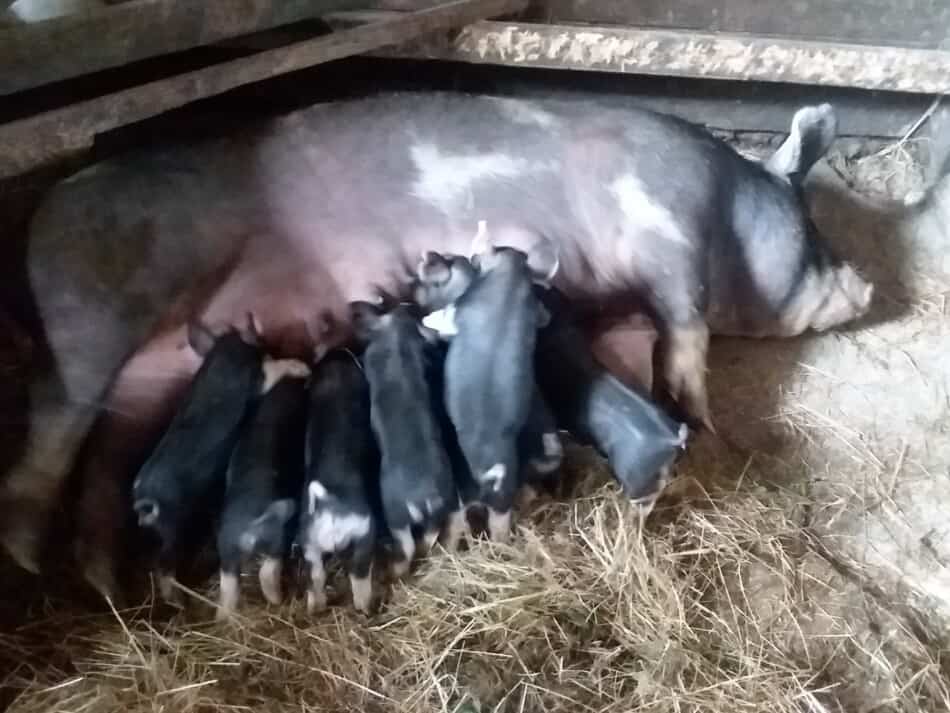
Breeding stock pigs sell for more than meat pigs
The final category for selling pigs would be breeding stock. Breeding stock quality pigs are selling for $400-2,300 each.
These are prices that I could find listed on sites, I’m sure the range is larger, like for specific show pig genetics.
Breeding stock pigs should sell for more than pigs for meat
First off, these pigs are going to sell for more than meat or market pigs.
For instance, a feeder pig for meat will sell for $100 in the spring, I would expect to pay more like $200 for a high quality pig with breeding stock potential.
Same idea for bred or breeding age gilts, they should cost more than a finished butcher hog!
Cobblestone Farms in Saskatchewan, Canada, has weanling pigs (feeder pigs) for $130 or registered breeding stock potential weanlings for $400 each.
Sugar Mountain Farm of Vermont has select pigs available through out the year, price varies with the season. Read through this blog, there is some interesting information here, well worth your time.
Boar prices are more volatile
Boar price range is huge, from $400-10,000+ depending upon the genetics and demand.
Here’s an article about a Yorkshire boar selling for $270,000! Wow, that’s crazy stuff! I put this in to show you there really is no limit to breeding stock prices, it’s whatever the buyer and seller agree on.
Boars are a bit different here, they are worth quite a bit, until no one wants them, then they are worth near nothing.
Raising boars for sale as breeding stock is risky, it’s tough to find a buyer unless you have all star stock. It’s not that folks are getting out of pigs, the number of people getting into pigs appears to be rising.
Then what’s the catch? Most folks, especially small farmers or beginners, will use A.I. rather than use their limited space and budget to buy and keep a boar.
A.I. is just too easy, specifically for anyone short on space.
A high demand show type boar will sell for thousands, where as a high quality purebred or purpose bred farm boar will sell for around the same price as the breeding age females.
The Hereford boar I just bought this summer was $110, that’s less than the price of him as a barrow of the same weight. This is what I meant by near nothing prices, I got a deal the seller did not!
The sale before I saw a really nice Yorkshire boar, registered, sell for $25. I didn’t want that type of boar at the time so I had to pass, but he looked good.
Worse yet is an older boar, you might get $5, seriously, if the auction will take them, at all.
Breeding age females in decent condition are always at least acceptable prices, based on the market, of course, because they continue to have meat value, as sausage, if nothing else. Boars, not so much.
Supply and demand sets prices for all pigs, no matter how they are sold
No matter what the season or where you live, supply and demand rule the roost, as far as prices go for pigs. This is basic economics.
When pigs are the hot thing, prices are up. When pigs are “old news” prices are down because everyone that was in it for the quick buck or because it looked easy is getting out.
If you are going the direct to customer route, know that it will take some time to get your name out and to have people talking about your pork, which will bring you new customers!
My favorite channels for videos on this type of information are:
- J&L Green Farms, a outdoor pastured pork and beef farm in Virginia (channel name is Farm Builder)
- Sheraton Park Farms, a pastured pig and poultry farm in North Carolina.
Both farms have websites and very insightful YouTube channels. Also, both places occasionally hold classes teaching what they do regarding the animals and marketing.
Social media could be an easy place to start your marketing, after all folks have to know what you have available before they can buy it. Start early so you have time to get the word out!
